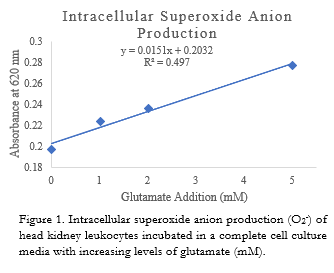EFFECTS OF DIETARY GLUTAMATE ON THE GROWTH PERFORMANCE AND IMMUNE RESPONSE OF HYBRID STRIPED BASS Morone chrysops x M. saxatilis
Certain dispensable or nonessential amino acids synthesized by the body have been demonstrated to provide some enhanced physiological roles in animals when supplemented in the diet, and thus have been termed functional amino acids. Glutamate has been identified as a possible functional amino acid for fish. Therefore, an 8-week feeding trial was conducted to evaluate the effects of varying levels of dietary glutamate on growth performance, immune responses, and whole-body composition of juvenile hybrid striped bass. Three diets were formulated from practical ingredients to contain 43% crude protein and 12% lipid, to which L-glutamate was supplemented at either 0, 1.0 or 2.0% of dry weight. All diets were randomly assigned to quadruplicate groups of 15 juvenile hybrid striped bass (HSB) initially averaging 5.65 g/fish in 110-L aquaria connected as a recirculating aquaculture system and fed twice daily at a percent of body weight which approached apparent satiation. A preliminary in vitro study also was conducted to evaluate if immunological responses of head-kidney isolated leukocytes from HSB would be affected by incremental levels of glutamate, glutamine and their combination in the culture media. Leukocytes were incubated overnight in a complete cell culture medium containing physiological levels of plasma amino acids as a control, while experimental groups were incubated with the reference media coupled with separate glutamate (1.0, 2.0, and 5.0 mM) and glutamine (1.0, 2.0, and 5.0 mM) supplementation, as well as a combined glutamate and glutamine (1.0 mM) treatment.
HSB fed diets containing incremental levels of glutamate did not present differences in terms of percent weight gain ( average of 649 % of initial weight), feed efficiency (FE) (average of 0.75), whole-body composition, hepatosomatic index (HSI) , or plasma amino acid composition. However, i ntraperitoneal fat (IPF) ratio was significantly (P < 0.05) higher in fish fed the basal diet (5.75%) when compared to those fed the diet supplemented with glutamate at 2.0% (5.01%). F illet yield was also significantly higher in fish fed the basal diet ( 31.7%) when compared to th ose fed the diet supplemented with glutamate at 1.0% (29.9%) .
In vitro intra- and extracellular superoxide anion (O2- ) production were linearly correlated with the addition of increasing glutamate levels while t he coupled treatment of glutamate and glutamine (1.0 mM ) produced the greatest respiratory burst response of head-kidney- derived leukocytes. The current experiment suggested a negligible in vivo response of HSB fed diets with elevated levels of glutamate while in vitro immunological responses to glutamate addition were more apparent.
